AGRONOMIC UPDATE – September 15, 2022….Harvest is close….
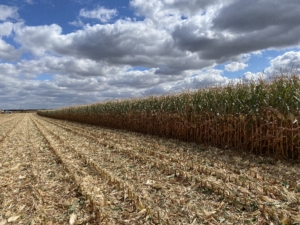
Harvest is very close…a few dryland corn and soybean acres are starting to come out….hearing low 30’s to upper 20’s on the dryland corn moistures and 13 or so, on soybean moisture on dryland.
Topics
- Growing Degree Day Update/Weather Update
- Current Corn Conditions….
- Pre Harvest…
As of September 14th, we have accumulated approximately the following for Growing Degree Units in 2022:
Planting Date GDU’s2021 Average GDU Departure from average
April 21 2876 2716 +160 (+8 days)
April 28 2810 2646 +164 (+8 days)
May 9 2747 2575 +172 (+8.5 days)
As of the above numbers, we have accumulated enough GDU’s to mature just about all hybrids in the April planting dates and very close in the mid-May planting dates. Only hybrids that are true black layer currently, are 106 and earlier, planted in April….and quite a bit of dryland of course.
Current Crop Conditions….
- Much of the corn crop is at 2/3 milk line to almost black layer, depending upon planting date and hybrid.
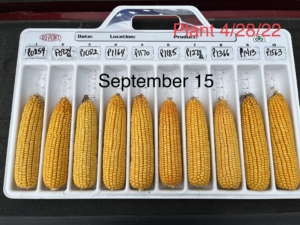
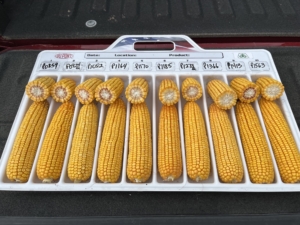
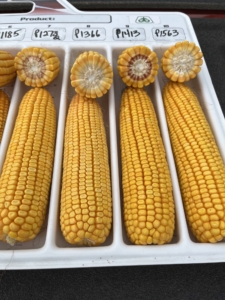
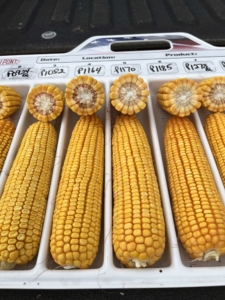
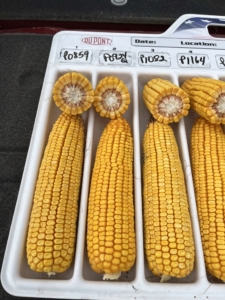
- The photo above compares ear size and type across new and current hybrids from the Pioneer Show Plot. Ear size and length is very similar to prior years here. The other photos are the same ears, but showing maturity line and grain color. It may be a little hard to tell in the photos, but grain quality and color are looking very good right now. The new hybrids are looking good for both kernel depth and test weights. The high test weight hybrids, like 1185, are almost ‘candy corn’ color right now. One can see that we are very close to black layer here. Keep in mind the mid-May planting dates yet, on full season hybrids (1278, 1563), for another watering first of the week if no rain.
- Over the past two weeks, we have been seeing more and more late-season N deficiency show up on lower leaves across both heavy and lighter soils. These symptoms are slowly working there way up the plant as each week goes on. We normally see some of this is dry years, as conditions have not been as conducive for N mineralization as the past few years. Also, as mentioned in a prior update, overall root mass is most likely less than in previous years (what you see above ground, is what you have below ground). A reduced root system size would mean a reduced area to scavenge for both nutrients and water, compounded under drought and limited water availability.
- Video link on current staygreen conditions in the Pioneer Show Plot – September 15, 2022….Pioneer Show Plot – Staygreen
Pre-Harvest….
- From all appearances, it looks like the key word to use to describe yields (both corn and soybean) in 2022 will be variable. The amount of available water, the early planting conditions, residue, hot temperatures and areas of spider mites, have all created more variability in area fields than we have seen for a few years. This is related to harvest stands and overall ear size and kernel depth/weight. The continued dry weather has exposed more center pivot issues over the past few weeks as well.
- The main key overall on yield will almost certainly be water availability.
-
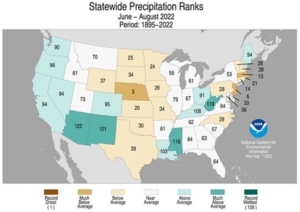
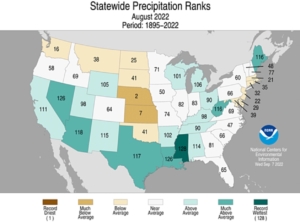
- The above photos show Stateside Precipitation Ranks for June-August 2022 and August 2022. As you can see, Nebraska has the dubious honor of being the driest in the country over these periods. NE has had the 3rd driest June-August over the past 125+ years and the 2nd driest August (hard to believe when you consider this includes the ‘dirty 30’s!). We see the impact of this dry weather in the dryland acres, but it has to have some impact on the irrigated as well. Its hard to believe that we can have above trendline irrigated yields over a wide spread area when our dryland looks this rough.
- Especially when you consider how much water was needed in 2022. Since January 1, we have had ET rates of 47″ as of September 14th. 10 year average is 31+”. This is over 15″ above average for total ET. Couple this with the fact that we are almost 11″ below normal for the year in total precipitation and one can readily see why our dryland looks as it does.
- Of the 47″ of total ET, 40″ has been from April 1 to Sep 14th. Over the growing season, we needed to come up with 20-25″ of water to cover the increased ET and rainfall deficit. This is why the sand acre never shutoff all year and why we may find out that the heavy soils needed more water than what was actually applied. In many cases, irrigation just replaced the normal rainfall deficit, plus a little more…meaning we were potentially short of overall water needs…. Irrigation was never meant to supply all the water needs of the crop….
- It has to rain in August to make soybean yield! This is something we did not get in 2022. Expectations would be for lower dryland soybean yields than we have seen for some years. Keep in mind the yield loss on soybeans from low harvest moistures. Be ready to ‘get them’ early if conditions stay hot and dry….
- The amount of stress, from the above factors) that has been on this crop has been the highest we have seen in 10+ years. This has the potential to lead to increased late-season standability issues….especially on those irrigated fields that had increased moisture stress over the summer. Most all fields have some plants that are shutting down prematurely as of this update.
- Bottom line….this will be a good year to have everything ready to go for harvest and to not ‘wait’ for the perfect conditions or harvest moisture. Getting finished with harvest in a timely manner will pay dividends this year….harvesting earlier means better conditions to ‘air-dry’ the grain in storage as well.
- The Good News!…yes, there is good news….Kernel counts, grain color and grain quality look very good. We expect high test weights (irrigated). This should lead to good grain storage. However, keep in mind the amount of ‘fines’ that will go in a grain bin if mixing dryland corners and irrigated together in a bin.
- Yields have the potential to be very good in many fields….whether as good as the last few years remains to be seen….
Thanks for your support and please contact us with any questions or concerns you may have!
Starman Seed Service, Inc.

